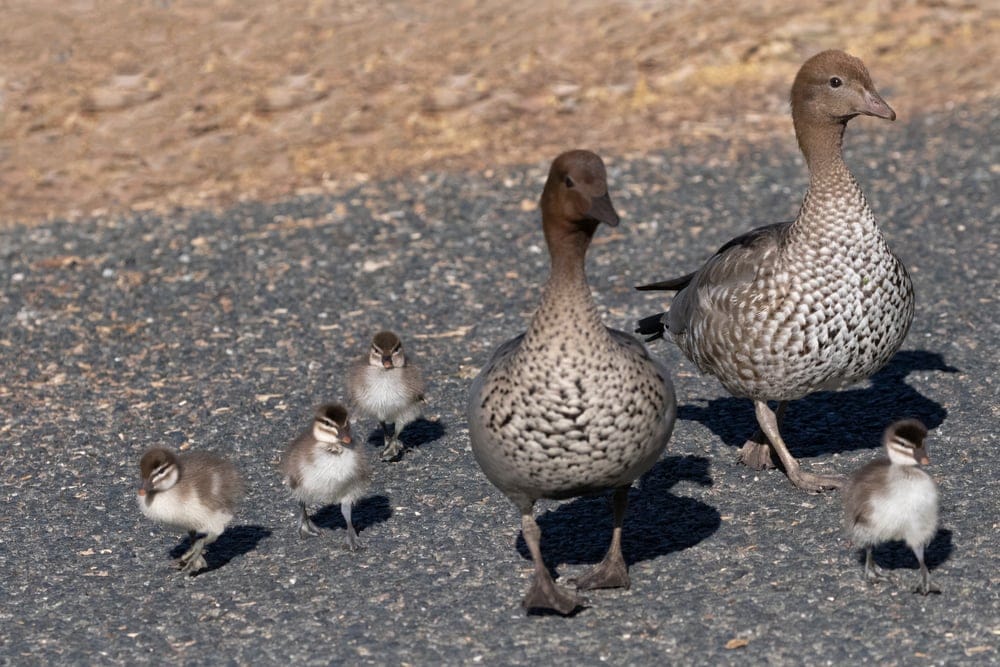The rare and precious Australian Spotted Duck is a duck breed that had its beginning in the US, which may surprise some, given its name. A Bantam breed, the Australian Spotted Duck is best known for its gentle temperament, rarity, historical significance in the world of exhibitions, and of course, its beauty. Today, only a small number of Australian Spotted Ducks remain.

Quick Facts about the Australian Spotted Duck
| Breed Name: | Australian Spotted |
| Place of Origin: | USA |
| Uses: | Exhibitions, pet, eggs, meat (less commonly), foraging |
| Drake (Male) Size: | 2.0 – 2.2 lbs |
| Hen (Female) Size: | 2.0 lbs |
| Color: | Various |
| Lifespan: | 9 – 12 years |
| Climate Tolerance: | All |
| Care Level: | Medium |
| Production: | Eggs, meat (less commonly) |
Australian Spotted Duck Origins
The Australian Spotted Duck was first bred in the 1920s. Mr. John C. Kriner and Stanley Mason interbred a diverse combination of four breeds—an unknown Australian breed, a Mallard, a Call, and a Northern Pintail.
The resulting offspring were selected based on the breeders’ criteria and bred, which produced the Australian Spotted Duck as we know it today. In 1928, the breed was shown to the world in an exhibition for the first time after several years of work to achieve the desired breed characteristics.
As of 2022, the Australian Spotted Duck is still not recognized by the American Poultry Association. That said, the breed is still popular in showing and a great deal of interest surrounds it due to its scarcity.
Australian Spotted Duck Characteristics
The Australian Spotted Duck has a small head, a white line that circles the neck (males), a body shaped like a tear, a rounded beak, and chubby cheeks well-proportioned with the body. The legs are perfectly centered, and these ducks also have a short tail.
Females weigh approximately 2.0 lbs, and males approximately 2.2 lbs, making them one of the smaller duck breeds. Overall, they have what can be best described as a cute, delicate (though they’re a hardy breed) and gentle appearance to match their temperament.
Temperament-wise, the Australian Spotted Duck is a peaceful soul with a calm, undemanding disposition. This breed has been known to befriend both people and other ducks, making them a popular pet with those lucky enough to acquire one.
Hens lay medium-sized eggs in a variety of colors—blue, green, and cream. They reach sexual maturity early and begin courting at about 4 weeks of age. Hens make wonderful mothers and produce approximately 50 to 125 eggs per year.
A Bantham breed, Australian Spotted Ducks are accomplished flyers. They’re also great foragers and can often be found making themselves useful on farms and around ponds helping to weed out and eliminate pests.
Uses
Due to the breed’s scarcity, it isn’t really raised for meat or eggs. This happens on occasion, but quite rarely. Hens produce a limited number of eggs per year, though they are quite large in size. Australian Spotted Ducks are usually acquired as pets and show ducks by enthusiasts, who likely appreciate their cuteness, beauty, historical significance, and foraging powers.
Appearance & Varieties
There are three Australian Spotted Duck coloring varieties—Greenhead, Bluehead, and Silverhead—these refer to the duck’s head color. Greenheads have a body that’s fawn in color with dark brown spots. This is the same in Blueheads and Silverheads, but in Blueheads, their spots are blue-grey and Silverheads have silver spots and flecks.
Population/Distribution/Habitat
The Australian Spotted Duck population is currently very low—in the hundreds. The breed enjoys marshes, ponds, and dense grassy areas in the wild. Domesticated Australian Spotted Ducks need an enclosed space to prevent them from flying out, and a clean pool/pond area to bask and roam with plenty of grass and shrubs that can offer shade—this breed seeks out dense shrubbery in the wild.
A non-aggressive breed, Australian Spotted Ducks aren’t the best at protecting themselves against predators, so extra precautions should be taken. Fence off the area and provide a shelter for the ducks to go to at night to keep them safe.
The Australian Spotted Duck is an omnivore, so can eat and forage for a variety of foods including crustaceans, insects, seeds, and grass. You can also provide a commercial, pellet-based diet to make sure they’re getting all of the nutrients they need. Laying hens should have access to oyster shell grit, and always have fresh drinking water on hand.

Are Australian Spotted Ducks Good for Small-Scale Farming?
Australian Spotted Ducks, as a critically endangered breed, are often kept by enthusiasts and as companion animals. Their eggs, which are said to be large with a good yolk, are sometimes sold but not commonly. It’s even rarer to raise Australian Spotted Ducks for meat, as this goes against preservation efforts.
Related duck breed reads:
Featured Image Credit: Florence-Joseph McGinn, Shutterstock
